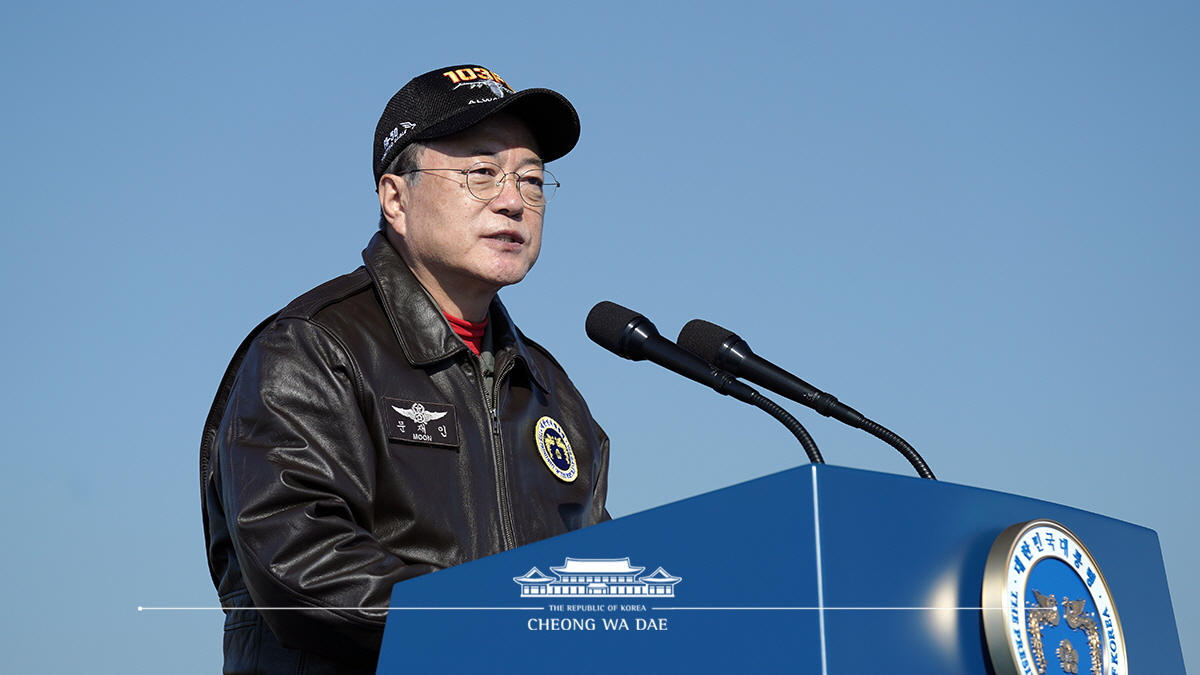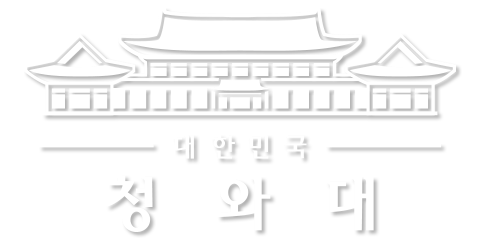이 웹사이트는 제19대 대통령 임기 종료에 따라 대통령기록관이 「대통령기록물 관리에 관한 법률」에 의해 이관받아 서비스하는 대통령기록물입니다. 자료의 열람만 가능하며 수정 · 추가 · 삭제는 불가능합니다.
다만, 「개인정보보호법」에 의하여 개인의 정보를 보호받기 원하시는 분은 관련 내용(요청자, 요청내용, 연락처, 글위치)을 대통령 웹기록물 담당자(044-211-2253)에게 요청해 주시면 신속히 검토하여 조치해 드리겠습니다. 감사합니다.
SPEECHES & REMARKS
BRIEFINGS
Congratulatory Remarks by President Moon Jae-in at Seoul International Aerospace and Defense Exhibition 2021 (Seoul ADEX 2021)

Fellow Koreans, distinguished guests from home and abroad,
Today, the defense industry capabilities of 440 businesses from 28 countries have been brought together and put on display here. The defense industry has helped defend the land, skies and waters of our territory and partnered with private industry as it progresses. For its new takeoff, it will demonstrate what it has achieved so far. I wholeheartedly congratulate you on the opening of the Seoul International Aerospace and Defense Exhibition 2021. I extend a warmhearted welcome to defense ministers and government delegations from across the world as well as ambassadors to Korea and defense business leaders.
Despite the COVID-19 situation, the ADEX operation headquarters staff and military service members have worked hard to prepare this exhibition – its largest ever – so it can be held in a safe and successful manner by taking thorough anti-epidemic measures. I offer my encouragement to all of them. Today, I became the first president of the Republic of Korea to board a Korean-made fighter jet and fly in our airspace. After taking off from Suwon Air Base, I flew over the Independence Hall of Korea in Cheonan, the Seoul National Cemetery and the War Memorial of Korea in Yongsan before landing here. I could feel for myself the commanding presence of the FA-50, which was developed with indigenous technology. Capable of advanced training, air combat and precision bombing, the FA-50 is an excellent light attack aircraft that has proven its remarkable price-to-performance ratio. A solid defender of our airspace, this fighter jet is being exported around the world.
On display in this indoor exhibition hall is a collection of weaponry that will be the forefront of the future defense industry, including drones, robots, space equipment and lasers. Awaiting visitors on a runway-turned-outdoor exhibition space are next-generation fighter jets, the brainchild of cutting-edge technological convergence and integration; helicopters; unmanned aerial vehicles; and such ground combat equipment as tanks, self-propelled howitzers, armored personnel carriers and anti-missile systems.
With the FA-50 leading the pack, the weaponry that has been forged by combining the Republic of Korea’s defense-related science and capabilities truly makes me reassured and proud. Those at the Agency for Defense Development, research institutes and other companies in the defense industry have dedicated themselves to advancing national defense science and technology as well as the defense industry to date. I vigorously applaud them all.
Fellow Koreans,
The defense industry is an important pillar of dependable defense that impermeably protects the people’s lives and property. As a security industry, it is also a key strategic industry for the country that has high growth potential as it is tied to civilian industries. We were dependent on foreign aid for weapons and equipment until the late 1960s when our defense industry was launched in the spirit of “making weapons for our military with our own hands.” Over the past 50 years, the Agency for Defense Development has developed 300 different kinds of weapons and transferred over 600 national defense technologies to the private sector. By investing 41 trillion won in defense technology R&D, we have earned economic gains of 443 trillion won, a more than 10-fold return.
My Administration made “rooting out defense acquisition-related corruption and nurturing a Fourth Industrial Revolution-ready defense industry” one of our 100 policy tasks and has unwaveringly pushed for it. Also, our Defense Industry Development Plan has been put in place to enhance transparency and fairness in related acquisition programs and to turn the industry into one driven mainly by exports, not domestic demand. Investments in improving our country’s defense capabilities have also significantly increased. For their part, private-sector businesses have actively invested as well, backing the development of key materials and localized production of parts.
Taken together, all of these efforts have helped Korea emerge as the world’s 6th largest defense industry exporter last year – up four notches from 4 years ago. In our defense industry, there are at least 550 businesses, including large companies, SMEs and mid-market firms and suppliers. These new growth engines have created approximately 45,000 jobs.
Fellow Koreans,
Now, the whole world is a stage for our defense industry. Currently, the global defense market is changing significantly due to artificial intelligence, drones, robots and other Fourth Industrial Revolution-related technologies. The teaming up and platformization of manned and unmanned weapons systems have become an irreversible defense industry trend. This is indeed a novel opportunity for those of us who are strong in innovation. Now is the time for us to move from “fast follower” to “future pacesetter” in the defense industry as well.
The Government will take on challenges in an innovative and bold manner in tandem with changes in the security environment and technological progress. Between now and 2026, the proportion of domestic spending allocated for improving defense capabilities will increase more than 80 percent, and support for the localized production of parts will more than quadruple. We will make preemptive investments to develop top-notch, game changing technology that can alter the way future wars are fought. We will also seamlessly implement the policies laid out to help globalize our defense industry and to strengthen industrial competitiveness, for instance, by promoting the purchase of Korean-made products and creating defense industry innovation clusters closely linked to local areas.
On October 7, the Defense Science and Technology Committee was launched, consisting of representatives from the military, government, business, research institutes and universities. We will establish a joint public-private implementation system to muster national capabilities for the development of defense science and technology. Technologies to be developed will be transferred to the private sector, which will help create a virtuous cycle that contributes to the national economy.
The aerospace sector has tremendous growth potential. This sector is forecast to see the fastest post-COVID-19 recovery. Notably, the urban air transportation sector will register steep growth, and therefore, it is indispensable to secure a commanding position in this market. Ranking 6th in machinery, 4th in automobiles and 1st in semiconductors globally, Korea has sufficient potential for the aviation industry’s advancement.
We can take the lead in the aerospace field, which is closely linked to our fundamental industries. We will be the first to introduce next-generation state-of-the-art mobility and make it a part of everyday life through prompt performance tests and institutional improvements. Moreover, the localization of aircraft engines will enable fundamental national security and aviation industry capabilities to be reinforced simultaneously. We will boldly take on the challenge of developing engines, the heart of aircraft, on our own, going beyond the achievement of using indigenous technology to develop our next-generation fighter the KF-21 Boramae. By independently developing various engines for fighter jets and other manned or unmanned aircraft by the early 2030s, we will build up our capacities to become one of the world’s top seven aviation powerhouses.
The universe is a space with infinite possibilities. Last July, we successfully test fired a solid-fuel propellant engine, taking a great stride toward the space age. Tomorrow, the Korean space launch vehicle, Nuriho – made with our own technology – will carry a mock satellite on its maiden launch. Besides transferring solid-fuel launch vehicle technology to the private sector, the Government will concentrate its efforts on securing key technologies and fostering a private space industry, so we can move toward becoming a space powerhouse. We will accomplish self-sufficiency in materials, parts and equipment by expanding investment in space-related civil-military cooperation projects. The space industry – with the private sector playing a central role – will begin in earnest.
Pioneering state-of-the-art defense and aerospace fields requires a lot of capital and technological capabilities. Cooperating internationally beyond any single country’s technology and market is vital. Korea will always stand by other countries. We will share the experience gained from developing our defense industry. As a country fully aware of how difficult it is to acquire advanced technology, we pledge to engage in active technological cooperation such as joint production and technology transfers, moving beyond mere exports. Various models of mutually beneficial cooperation based on trust will be created.
Fellow Koreans, distinguished guests from home and abroad and leaders in the aerospace and defense industries,
The purpose of a strong national defense is always peace. Korea aims to have a smart and powerful military based on advanced science and technology. We will build peace together with countries around the world. The defense industry will be developed into a key national growth engine that goes beyond national defense. We will work in solidarity and cooperation with the world for secure lives and sustainable prosperity.
The defense industry cannot advance without the support of our people. During this five-day exhibition, I’d like everyone to see for themselves the true stature of our defense capabilities, which have advanced splendidly. I hope you support our defense industry while dreaming of our own aerospace industry, taking pride in our self-reliant national defense and harboring a deep aspiration for peace.
Thank you.



